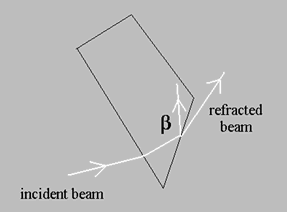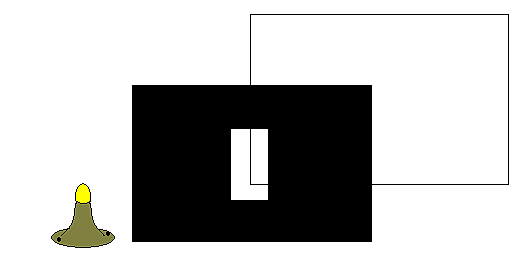Student Content Assessments
Instrument 9: Conceptual Questions in Optics
Project: A
Course in Laser and Optical Physics at Western Michigan University
Western Michigan University
Funding Source: NSF - Division of Undergraduate Education (DUE)
Purpose: To
assess student learning in a Web-based physics course about
biofilm
Administered To: Undergraduate
students
Topics Covered:
- Content Specific Assessments: biofilm, optics
Format/Length: 4
closed-ended and 5 open-ended questions
Conceptual Questions in Optics
1. The below show the intensity distributions on a distant
screen when light from a 633nm HeNe laser passes through several
different two-slit apparatuses.
A. Rank these in ascending order of slit separations
B. Rank these in ascending order of slit widths
2. The sketch below shows a view from an airplane looking down on an ocean wave that moves over a level sea floor towards shore (the direction of motion of the wave is indicated by an arrow). The shaded region indicates an area where the sea floor has a shelf. The wave speed is different in the two regions. Determine the ratio of the wave speeds in the two regions. Feel free to use ruler and/or protractor to make this measurement (if possible).
3. A quarter wave plate is placed between two crossed polarizing filters as shown and the system is illuminated with natural light. Describe the changes in the intensity of the transmitted light when the quarter wave plate is rotated and explain why these changes occur.
4. In an experiment on total internal reflection, a beam of white light was sent through a prism as shown. The prism was rotated until all the light was internally reflected and there was no refracted ray.
 |
A. If the refracted ray disappears when the angle ß
between the incident and reflected ray is 100.6°,
find the index of refraction of the prism material.
B. Just before the refracted ray disappeared, it changed
color. Explain this
|
5. The cardboard mask shown below contains a slit 1cm wide and 2 cm high. In a darkened room, the light bulb is turned on. Treat the bulb as a point source and for simplicity assume its light to be monochromatic.
A. What would you see on the screen if the bulb, mask and observing screen were arranged as shown?
B. How would your prediction change if the bulb were moved further and further from the mask? Assume that the bulb simultaneously increases in brightness so the intensity at the slit stays constant.
C. Assuming the bulb to be very far from the mask (and very bright), how would your predictions change if the slit were made narrower and narrower?
 |
6. By changing the separation distance between lens and film, a camera can focus on subjects at a variety of distances. Suppose the proper lens-film separation for taking an in-focus picture of a distant object such as the moon is d0. To take an in-focus picture of a nearby object, will the proper lens-film separation be greater than, less than, or equal to d0?
7. During a mission at the International Space Station, an astronaut is outside the station and watching as an American space shuttle docks with the station. Operators on the station direct a communication beam towards the shuttle, a beam from a red HeNe laser . Can the astronaut see the beam? Why or why not?
8. Prism and diffraction grating spectrometers can be used to study the spectral lines of atoms. For the finest detail, however, we must use a Fabry-Perot interferometer. What feature or features of the Fabry-Perot makes it so useful for examining fine details of spectral lines?
9. The below figure shows a mask formed by cutting three thin parallel slits in an opaque screen. An observing screen is placed some distance away and a converging lens, whose midplane is indicated by the line L, is placed between mask and screen. The middle slit lies directly over the midpoint of the lens and the observing screen lies at the focal point of the lens. The mask is illuminated from behind by a plane wave of monochromatic light directed parallel to the optic axis.
A. Draw the paths of light coming from the slits and reaching the point P on the screen.
B. Draw the wave fronts associated with these paths.
C. Compute the amplitude of the electric field at P
Notes:
Problem 1 taken from Karen Wosilait, et. al., Am. Journ. Phys.,
Suppl. 67 (7), July '99
Problems 2, 3, 4, and 8 by author
Problem 5 adapted from Bradley S. Ambrose, et.al. , Am. Journ.
Phys., 67 (2), Feb. '99
Problem 6 taken from Peer Instruction, Eric Mazur,
Prentice Hall, 1997
Problem 7 adapted from Igal Galili and Amnon Hazan, Am. Journ.
Phys., Suppl., 68 (7), July '00
Problem 9 adapted from P. Colin and L. Viennot, Am. Journ.
Phys., Suppl., 69 (7), July '01
|

